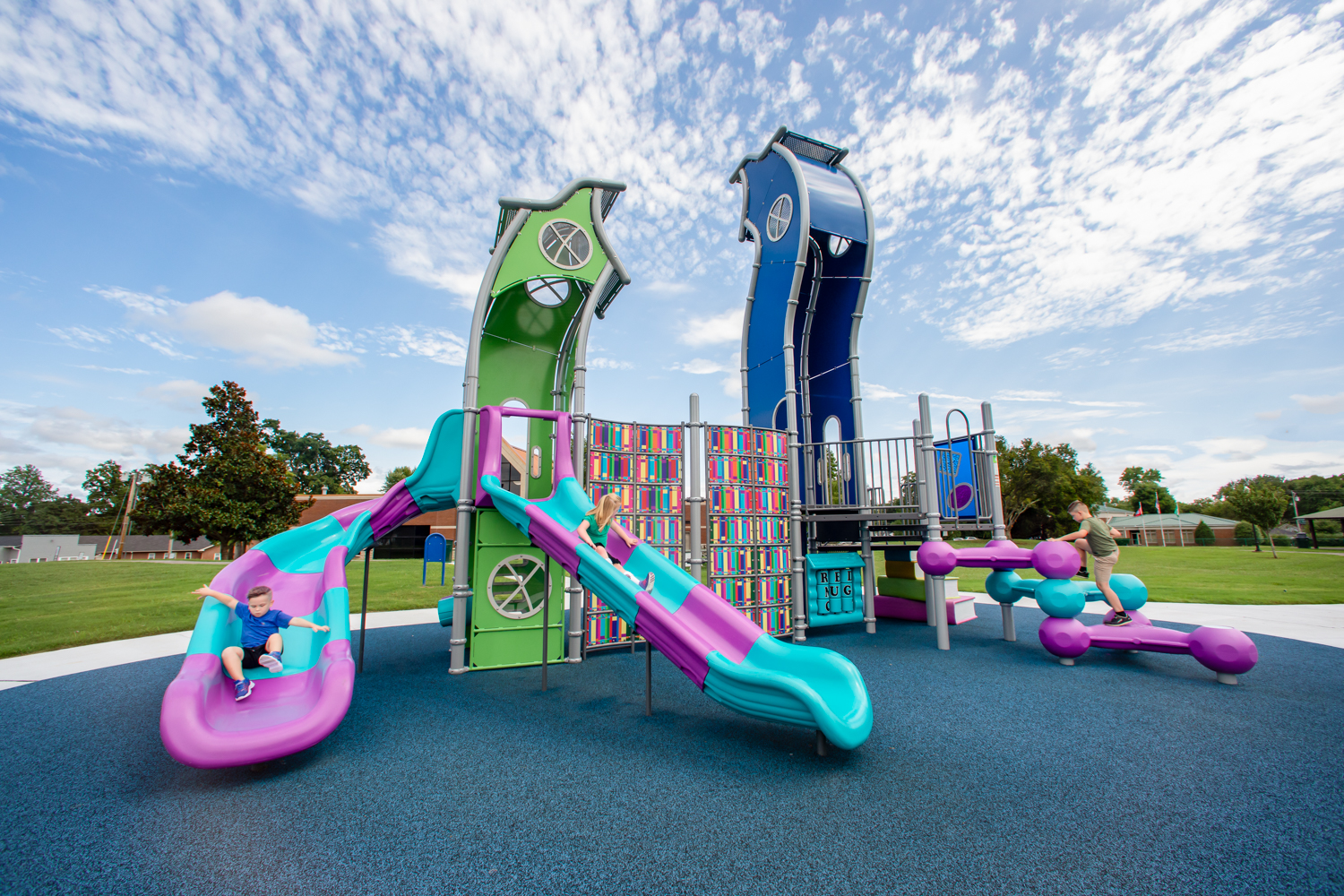Common Playground Equipment Terms
Posted by May Recreation Content Team on

Playgrounds have been an integral part of childhood for generations, providing children with opportunities for physical activity, social interaction, and imaginative play.
As playgrounds have evolved over time, so have the terms used to describe the equipment found within them. While merry-go-rounds and monkey bars are timeless, playground designers in 2023 have some thrilling new choices from sensory walking paths to playground climbers.
Evolution of Playground Terms
No matter what age you are today, you grew up in an era where the local playground had staples such as merry-go-rounds, monkey bars, teeter-totters, and slides.
There’s a good reason for that as those four playground items have been around for many generations. Here’s a look at the classic playground terms for equipment:
- Merry-Go-Round: Originally known as a "carousel," this spinning play equipment has been a playground staple for over a century. Children enjoy riding on the rotating platform, which provides a thrilling sense of motion and excitement. The first merry-go-round was created in the U.S. in the 1840s with a patent issued in 1871, but the concept goes back to the Byzantine Empire and the inspiration for today’s carousels came from the 12th century when knights tested their agility and jousting skills on merry-go-rounds!
- Monkey Bars: These horizontal bars, often resembling a ladder, became popular in the 1920s. They offer kids a chance to test their upper body strength and coordination as they swing and traverse from one bar to another. The first patent for monkey bars (by Princeton mathematician Ted Hinton) was sold under the trademarked name Jungle Gym.
“Climbing is the natural method of locomotion which the evolutionary predecessors of [humans] were designed to practice,” Hinton argued in his first patent, “and is therefore almost ideally suited for children.”
- Slides: Slides have been an iconic playground feature since the 1950s. They come in various shapes and sizes, offering thrilling descents that kids can't resist. Slides are typically constructed out of strong and sturdy plastic instead of metal like they were in days past – good news for those kids playing in Texas and other states with plenty of sunshine.
- Swings: Swing sets have remained a timeless favorite, promoting physical exercise, social interaction, and a sense of freedom as children swing through the air. Swings appear to be as old as time but the modern-day swing was invented by Charles Wicksteed in the early 1900s.
- Teeter-totters: Also known as "seesaws," teeter-totters offer an interactive experience for children as they balance and teeter back and forth. While the concept of teeter-totters dates back to ancient Greece (children would play with a plank balanced on a rock), the first modern patent was issued in 1905. Teeter-totters became must-have features of American playgrounds in post-World War II.
You could walk into any park in America in the 1960s and 1970s and find a merry-go-round, monkey bars, teeter-totters, swings, and slides … and children with smiles on their faces.
Contemporary Eras Common Playground Equipment Terms
Today, however, there are many more choices when it comes to playground equipment. Here are some choices modern playground equipment designers have:
- Playground Climbers: Modern climbers come in diverse forms, such as rope structures, rock walls, and net climbers. Climbers give kids a variety of play paths and help push the limits of their upper-body strength, coordination, agility, and stamina. Climbers also offer children a sense of accomplishment when they reach the top, with some climbers offering a bell to ring.
- Playhouses: Miniature houses or structures that serve as imaginative play spaces, fostering creativity and role-playing. Playground designers can even build an entire community around the concept of playhouses. A benefit of playhouses is that they are popular with children of all needs and abilities including those with autism, developmental delays, and those who use mobility devices.
- Sensory Panels: Panels with tactile elements, mirrors, and interactive features that encourage exploration and sensory stimulation. Miracle Recreation’s Sensory Panels, for example, combine the challenge of a traditional maze with imaginative play. Children and adults of all ages and abilities, including those with sensory disabilities, can explore the distinctive textures, shapes, and translucent colors of these reconfigurable panels by look and by feel, as a group or individually in their own, unique way.
- Sensory Walking Paths: These paths feature various textures and materials that stimulate children's senses as they walk or crawl, promoting sensory development. Miracle Museum’s Odyssey Hall, for example, is a sensory environment packed with fun, tactile features such as hanging flex treads, which provide deep touch, while vertical roto panels provide texture and color variety.
- Spinners: These spinning seats or platforms add a dynamic element to play, promoting balance and coordination while providing a thrilling sensation of movement.
- Spring Riders: Shaped like animals, vehicles, or other fun characters, spring riders offer a bouncing, rocking experience that engages children's imaginations.
- Still Rings: Often found in fitness-focused playgrounds, still rings allow children to perform gymnastic movements, fostering upper body strength and flexibility.
Common Playground Terms Related to Equipment Safety and Design
Of course, when it comes to playground equipment, there are some other common playground terms that designers should consider, especially when it comes to safety, such as:
- Designated Play Surface: This is a flat surface for standing, walking, crawling, or sitting that is greater than 2” wide by 2” long with an angle less than 30 degrees from horizontal. Designated play surfaces are typically made of materials such as wood chips, rubber mulch, or poured-in-place rubber.
- Entrapment: This is when a child gets any body part stuck in equipment, such as a railing, and can't withdraw the body part from the opening. Playground designers need to take steps to prevent entrapment, such as using rounded edges and avoiding gaps between components.
- Fall Height: This is the distance between the protective playground surfacing and the tallest designated play surface on a piece of equipment. Playground designers need to ensure that the fall height is appropriate for the type of equipment and the age range of children who will be using it.
- Fall Zone: This is the area around playground equipment where a child is likely to land if they fall off or exit the equipment or structure. The fall zone should be covered with a protective surface such as rubber mulch or rubber tiles.
- Safety Zone: This is the area around playground equipment that is designed to protect children from serious injuries if they fall off the equipment. The safety zone is typically made of a material such as rubber mulch or rubber tiles.
In addition to these terms, playground designers also need to be familiar with the following design principles:
- Accessibility: Playgrounds should be designed to be accessible to children of all abilities. This means including features such as ramps, accessible swings, and sensory panels.
- Variety: Playgrounds should offer a variety of play experiences to appeal to children of all ages and abilities. This could include swings, slides, climbing structures, net and rope structures, sensory panels, and other types of equipment.
- Safety: Playgrounds should be designed to be safe for children. This means using materials that are durable and safe and taking steps to prevent entrapment and other hazards.
- Sustainability: Playground designers should consider the environmental impact of their designs. This means using sustainable materials and construction practices.
As playgrounds continue to evolve and adapt to the needs of today's children, these common terms and equipment items remain timeless.
Playground equipment not only promotes physical health but also encourages social interaction, imaginative play, and sensory development, ensuring that children of all ages can enjoy these valuable outdoor spaces for generations to come.
Whether it's a classic merry-go-round or a cutting-edge sensory panel, each piece of equipment contributes to the magic of play and learning.
